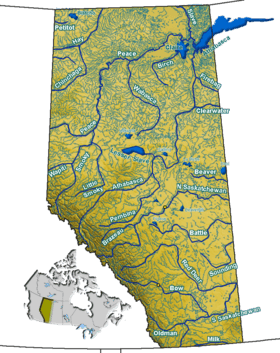Oldman River facts for kids
Quick facts for kids Oldman River |
|
|---|---|

Oldman River seen from Veterans Memorial Highway
|
|
| Country | Canada |
| Province | Alberta |
| Physical characteristics | |
| Main source | Canadian Rockies 2,100 m (6,900 ft) 50°06′50″N 114°43′14″W / 50.11389°N 114.72056°W |
| River mouth | South Saskatchewan River 701 m (2,300 ft) 49°55′45″N 111°41′27.4″W / 49.92917°N 111.690944°W |
| Length | 363 km (226 mi) |
| Basin features | |
| Basin size | 26,700 km2 (10,300 sq mi) |
The Oldman River is an important river in southern Alberta, Canada. It begins high up in the Rocky Mountains and flows generally from west to east. Along its path, it passes through communities like Fort Macleod and Lethbridge. Eventually, it joins the Bow River to form the South Saskatchewan River. This larger river then continues its journey all the way to Hudson Bay.
The Oldman River stretches for about 362 kilometres (225 mi). The area of land that drains into the Oldman River is huge, covering about 26,700 square kilometres (10,300 sq mi).
Contents
History of the Oldman River
A long time ago, the Oldman River was actually known by a different name: the Belly River. Today, the Belly River is a separate river that flows into the Oldman River.
In 1991, the government of Alberta finished building the Oldman River Dam. This dam helps control the river's water and provides water for farming. Before the dam was completed, some members of the Piikani Nation, led by Milton Born With A Tooth, tried to change the river's flow. They wanted to protect their land and traditions. This led to a disagreement about the dam's construction. The dam was built where the Oldman, Crowsnest, and Castle rivers meet.
The Peigan Timber Limit B and Peigan 147 are Indian reserves belonging to the Piikani Nation that are located along the river.
The 2013 Floods
On June 21, 2013, southern Alberta experienced very heavy rainfall. This caused major floods across many rivers, including the Bow, Elbow, Highwood, and Oldman rivers. Many towns and cities in southern Alberta declared emergencies as the water levels rose quickly. People in several communities had to leave their homes for safety.
Rivers Flowing into the Oldman
As the Oldman River flows from its source to its mouth, many smaller rivers and creeks join it. These are called tributaries. Here are some of the main ones:
- Livingstone River
- Crowsnest River
- Castle River
- Pincher Creek
- Beaver Creek
- Willow Creek
- Belly River
- St. Mary River
- Lee Creek
- Little Bow River
Nature Along the Oldman River
The Oldman River starts in a special place called the Beehive Natural Area. This area has high mountain plains (alpine tundra) and very old spruce and fir trees. Further downstream, the river flows through Bob Creek Wildland Park and Black Creek Heritage Rangeland. These parks help protect the natural environment. The Oldman Dam and Oldman River are also Provincial Recreation Areas, which means they are great places for people to visit and enjoy nature.
Over time, the river and its tributaries have carved out deep valleys called coulees in southern Alberta. The different layers of rock seen in these coulees help people find special ammolite deposits. Ammolite is a rare and colorful gemstone.
Fish Species in the Oldman River
The Oldman River is home to many different kinds of fish. Anglers (people who fish) can find species like rainbow trout, cutthroat trout, and bull trout. Other fish include brown trout, and even hybrid trout species like the "cutbow" (a mix of rainbow and cutthroat trout). You can also find mountain whitefish, pike, walleye, lake sturgeon, suckers, goldeye, and different types of minnows.
See also
 In Spanish: Río Oldman para niños
In Spanish: Río Oldman para niños


